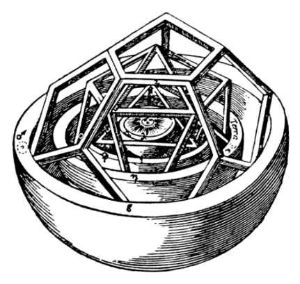The Sleepwalkers (116 page)
Authors: Arthur Koestler


They
were
also
called
the
"Pythagorean"
or
"Platonic"
solids.
Being
perfectly
symmetrical,
each
can
be
inscribed
into
a
sphere,
so
that
all
of
its
vertices
(corners)
lie
on
the
surface
of
the
sphere.
Similarly,
each
can
be
circumscribed
around
a
sphere,
so
that
the
sphere
touches
every
face
in
its
centre.
It
is
a
curious
fact,
inherent
in
the
nature
of
three-dimensional
space,
that
(as
Euclid
proved)
the
number
of
regular
solids
is
limited
to
these
five
forms.
Whatever
shape
you
choose
as
a
face,
no
other
perfectly
symmetrical
solid
can
be
constructed
except
these
five.
Other
combinations
just
cannot
be
fitted
together.
So
there
existed
only
five
perfect
solids
–
and
five
intervals
between
the
planets!
It
was
impossible
to
believe
that
this
should
be
by
chance,
and
not
by
divine
arrangement.
It
provided
the
complete
answer
to
the
question
why
there
were
just
six
planets
"and
not
twenty
or
a
hundred".
And
it
also
answered
the
question
why
the
distances
between
the
orbits
were
as
they
were.
They
had
to
be
spaced
in
such
a
manner
that
the
five
solids
could
be
exactly
fitted
into
the
intervals,
as
an
invisible
skeleton
or
frame.
And
lo,
they
fitted!
Or
at
least,
they
seemed
to
fit,
more
or
less.
Into
the
orbit,
or
sphere,
of
Saturn
he
inscribed
a
cube;
and
into
the
cube
another
sphere,
which
was
that
of
Jupiter.
Inscribed
in
that
was
the
tetrahedron,
and
inscribed
in
it
the
sphere
of
Mars.
Between
the
spheres
of
Mars
and
Earth
came
the
dodecahedron;
between
Earth
and
Venus
the
icosahedron;
between
Venus
and
Mercury
the
octahedron.
Eureka!
The
mystery
of
the
universe
was
solved
by
young
Kepler,
teacher
at
the
Protestant
school
in
Gratz.

Model
of
the
universe;
the
outermost
sphere
is
Saturn's.
Illustration
in
Kepler
Mysterium
cosmographicum.

Detail,
showing the spheres of Mars, Earth, Venus and Mercury with the Sun in
the centre.
"It
is
amazing!"
Kepler
informs
his
readers,
"although
I
had
as
yet
no
clear
idea
of
the
order
in
which
the
perfect
solids
had
to
be
arranged,
I
nevertheless
succeeded
...
in
arranging
them
so
happily,
that
later
on,
when
I
checked
the
matter
over,
I
had
nothing
to
alter.
Now
I
no
longer
regretted
the
lost
time;
I
no
longer
tired
of
my
work;
I
shied
from
no
computation,
however
difficult.
Day
and
night
I
spent
with
calculations
to
see
whether
the
proposition
that
I
had
formulated
tallied
with
the
Copernican
orbits
or
whether
my
joy
would
be
carried
away
by
the
winds...
Within
a
few
days
everything
fell
into
its
place.
I
saw
one
symmetrical
solid
after
the
other
fit
in
so
precisely
between
the
appropriate
orbits,
that
if
a
peasant
were
to
ask
you
on
what
kind
of
hook
the
heavens
are
fastened
so
that
they
don't
fall
down,
it
will
be
easy
for
thee
to
answer
him.
Farewell!"
3
We
had
the
privilege
of
witnessing
one
of
the
rare
recorded
instances
of
a
false
inspiration,
a
supreme
hoax
of
the
Socratic
daimon
,
the
inner
voice
that
speaks
with
such
infallible,
intuitive
certainty
to
the
deluded
mind.
That
unforgettable
moment
before
the
figure
on
the
blackboard
carried
the
same
inner
conviction
as
Archimedes'
Eureka
or
Newton's
flash
of
insight
about
the
falling
apple.
But
there
are
few
instances
where
a
delusion
led
to
momentous
and
true
scientific
discoveries
and
yielded
new
Laws
of
Nature.
This
is
the
ultimate
fascination
of
Kepler
–
both
as
an
individual
and
as
a
case
history.
For
Kepler's
misguided
belief
in
the
five
perfect
bodies
was
not
a
passing
fancy,
but
remained
with
him,
in
a
modified
version,
to
the
end
of
his
life,
showing
all
the
symptoms
of
a
paranoid
delusion;
and
yet
it
functioned
as
the
vigor
motrix
,
the
spur
of
his
immortal
achievements.
He
wrote
the
Mysterium
Cosmographicum
when
he
was
twenty-five,
but
he
published
a
second
edition
of
it
a
quarter
century
later,
towards
the
end,
when
he
had
done
his
life
work,
discovered
his
three
Laws,
destroyed
the
Ptolemaic
universe,
and
laid
the
foundations
of
modern
cosmology.
The
dedication
to
this
second
edition,
written
at
the
age
of
fifty,
betrays
the
persistence
of
the
idée
fixe
: